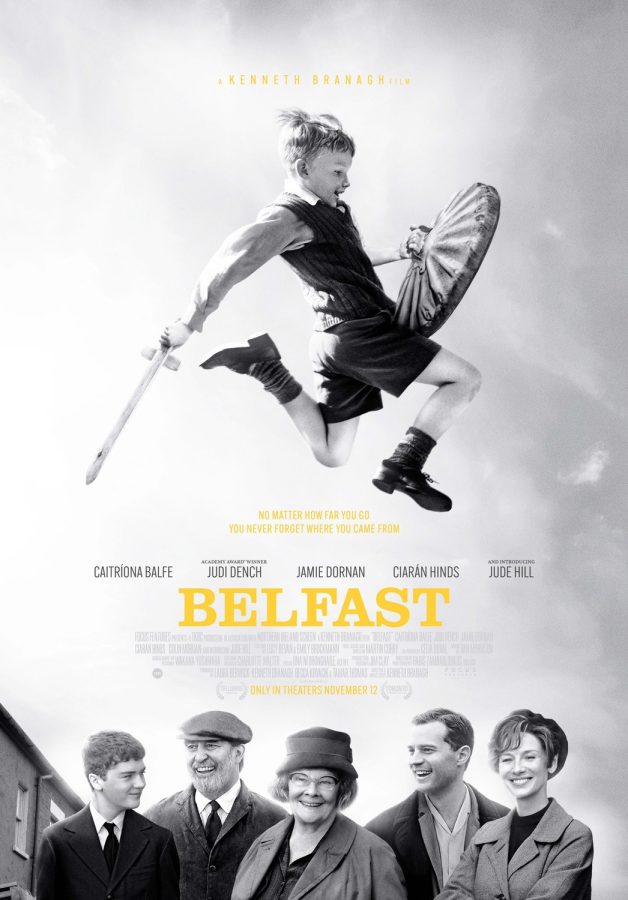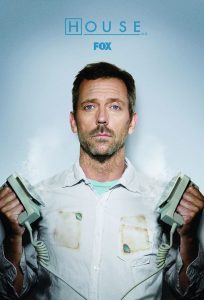“Belfast” review: Gradience in growing up
March 13, 2022
A memoir is not a tell-all. It is made up of a million little moments. Kenneth Branagh’s “Belfast” achieves just that, as it tells his childhood chronicle through the idealized eyes of Buddy (Jude Hill), a semi-fictional version of the director. Set within the backdrop of the Troubles in Northern Ireland, “Belfast” is a sentimentalized story of youth, conflict, and the co-existence of the two, while also finding contentment somewhere in between.
Filmed mostly in black and white with selective splashes of color, the film heightens the subjectivity of Buddy’s (or Branagh’s) youth. There is beauty behind the madness: magical moments occur as Molotov cocktails soar. Hard questions are being asked. Sacrifices are being made. Everything is up in the air as Buddy tries to hold tight to the roots he has planted in his hometown. It is in this gray area that he experiences life for what it is. Through warped Dutch angles and low-angle shots, the viewer meets him where he is, giving us a child’s point of view.
There is a contradiction in Buddy’s life. Catholics and Protestants once lived kindly side by side. Now Buddy and his Protestant family are being forced out of their homes– a place of formidable moments for young Buddy that is just starting to unfold in his golden view of Belfast. A Belfast that is falling apart at the seams.
What ties together “Belfast” is Caitríona Balfe’s performance as Ma, Buddy’s mother. Ma has done almost all of the work in raising her two boys and pulls the emotional weight in the film. As we see her in great stature from Buddy’s eyes, she seeks control for herself. Balfe’s performance is matched with Jamie Dornan’s portrayal of Pa, a mild-mannered yet complicated father. He is absent for most of Buddy’s life as he tries to do good by wife and family.
The tension of Buddy’s parents builds up with a quiet whispered intensity, as we see from peeks behind the corners of their home through Buddy’s eavesdropping. And behind those cracked open doors, through open windows, and ducked in the foyer below the stairs, Ma and Pa face a hard question: Do they stay in Belfast, the town they have grown and lived in their whole lives, knowing everyone turned against them? Or do they move to London, for security and a fresh start afforded by Pa’s work?
While most of the film is set in black and white, moments of Buddy’s meeting with the arts are rendered in Technicolor. In a family outing to see the 1968 musical “Chitty Chitty Bang Bang,” there is inquisitive wonder and escape in the communal experience of the movies, a place where things just make sense— as well as an allusion to what Buddy may become. It is in these moving moments that Buddy feels still, as Branagh emphasizes the relevance of autobiography in art.
While Branagh’s “Belfast” makes way for nostalgia, it unfortunately loses its reins in attempting to contextualize the sectarian violence. While the horrors only appear in fragmented moments and are oversimplified in comparison to their real-life magnitude, it is only representative of the Belfast that Kenneth Branagh knew as a child. Instead, “Belfast” is Branagh’s thank-you note to his youth, shaped by his town, his turbulent neighborhood, and his parent’s sacrifices. And while it is deeply romanticized and idyllic in its looking back, its strengths are in the universality of his story: of movement and displacement and the gray area of it all.
The gradience of life is not in high highs and low lows. It is in small moments and hard decisions. Branagh leaves the film with a dedication to each individual’s own story: “For the ones who stayed. For the ones who left. And for all the ones who were lost.” Despite not painting the whole picture of 1969 Ireland, it gives us perspective into Buddy’s: a cinematic look at life on screen, the good and the bad, and how dreams are found in cinema. Dreams are our own, and there is no one single story. It is through cinema that we become grateful for the grays of life.
“Belfast” is now showing in theaters.









